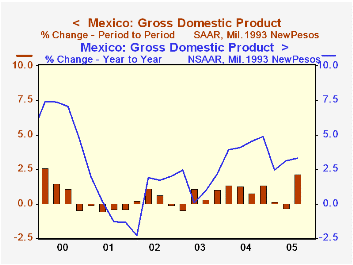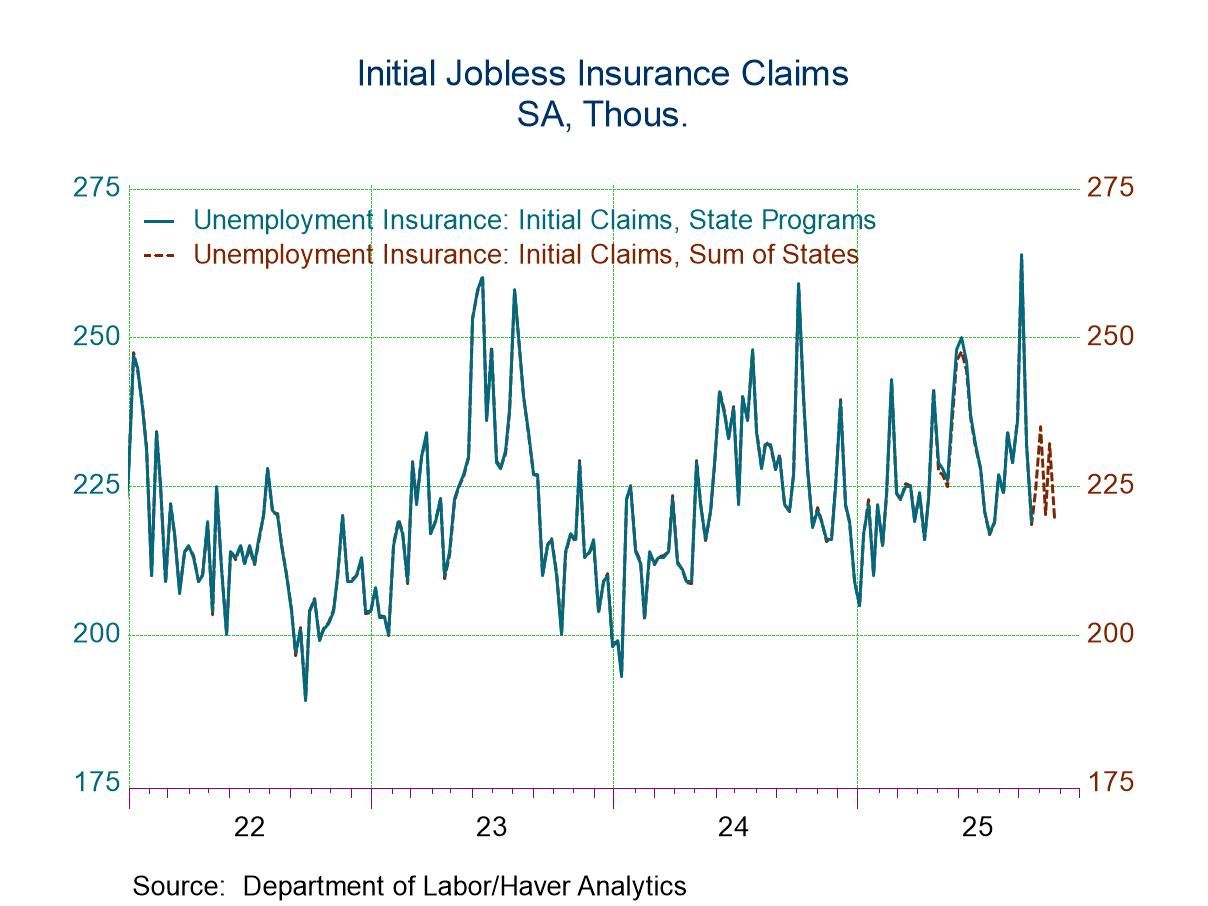 Global| Nov 17 2005
Global| Nov 17 2005Mexico's GDP Expands 3.3% in Q3: Is This Good or Bad?
Summary
Mexico's GDP was either strong or weak in Q3, according to who you listen to and which comparisons you make. The data were reported yesterday afternoon by INEGI, Mexico's statistical agency. The year-on-year gain of 3.3% was less than [...]

Mexico's GDP was either strong or weak in Q3, according to who you listen to and which comparisons you make. The data were reported yesterday afternoon by INEGI, Mexico's statistical agency. The year-on-year gain of 3.3% was less than a government forecast, Reuters explained, but slightly larger than private market forecasts. Seasonally adjusted, the quarter saw a 2.1% increase (quarterly rate) after a basically flat performance in Q1 (+0.2%) and Q2 (-0.3%). It was this pattern that Dow Jones highlighted, with a headline in the Wall Street Journal that read "Mexico Growth Picks Up...". 
A further divergence of interpretation concerns manufacturing. This important sector has experienced considerable variability in recent years. From Q3 2004, this latest period's value added rose a mere 0.2%, less than Q2's 2.6% yearly increase. The retreat was led by metals and metal products. Based on seasonal adjustment of the industry data by Haver Analytics, these, along with "other manufacturing", showed considerable quarter-to-quarter declines. Some attribute this to weakness in the US motor vehicle industry, although collateral data, such as unit vehicle imports into the US as published by the US Commerce Department, don't indicate any decline. At the same time, for the entire factory sector, some analysts apparently feared a decrease from a year earlier, so the 0.2% rise, modest as it is, was of some comfort.
Other notable sectors of the Mexican economy contributed to the mixed reading on its health. Agriculture, constituting a relatively small proportion of total GDP, had a substantial increase in Q3, 10.6% year-to-year after outright declines in the first half of 2005. Finance also strengthened, with a 6.2% increase; this industry group has been expanding consistently over the last couple of years. The largest sector of the Mexican economy is domestic trade and tourism, contributing just under 20% of GDP last year. This year, it continues to expand, but more slowly, with a 3.1% yearly increase in Q3, notably less than the 4.9% in 2004. As we face Q4, cross-currents will continue to raise questions for the nation: the storms in October, continuing uncertainty in the big US vehicle market, and volatile energy markets. Stay tuned.
| Mexico GDP & Select Industries, % Changes, NSA unless noted |
Q3 2005 | Q2 2005 | Q1 2005 | 2004 | 2003 | 2002 |
|---|---|---|---|---|---|---|
| Real GDP, SA (100%*) | 2.1 | -0.3 | 0.2 | -- | -- | -- |
| Yr/Yr, NSA | 3.3 | 3.1 | 2.4 | 4.4 | 1.4 | 0.8 |
| Agriculture (5.3%*) | 10.6 | -3.3 | -1.5 | 4.0 | 3.5 | 0.1 |
| Manufacturing (18.2%*) | 0.2 | 2.6 | -0.2 | 3.8 | -1.3 | -0.7 |
| Wholesale & Retail Trade/Restaurants & Hotels (19.8%*) |
3.1 | 3.5 | 3.3 | 4.9 | 1.6 | 0.0 |
| Finance/Insurance/ Banking (15.9%*) |
6.2 | 5.5 | 5.1 | 4.6 | 3.9 | 4.2 |
Carol Stone, CBE
AuthorMore in Author Profile »Carol Stone, CBE came to Haver Analytics in 2003 following more than 35 years as a financial market economist at major Wall Street financial institutions, most especially Merrill Lynch and Nomura Securities. She had broad experience in analysis and forecasting of flow-of-funds accounts, the federal budget and Federal Reserve operations. At Nomura Securities, among other duties, she developed various indicator forecasting tools and edited a daily global publication produced in London and New York for readers in Tokyo. At Haver Analytics, Carol was a member of the Research Department, aiding database managers with research and documentation efforts, as well as posting commentary on select economic reports. In addition, she conducted Ways-of-the-World, a blog on economic issues for an Episcopal-Church-affiliated website, The Geranium Farm. During her career, Carol served as an officer of the Money Marketeers and the Downtown Economists Club. She had a PhD from NYU's Stern School of Business. She lived in Brooklyn, New York, and had a weekend home on Long Island.





